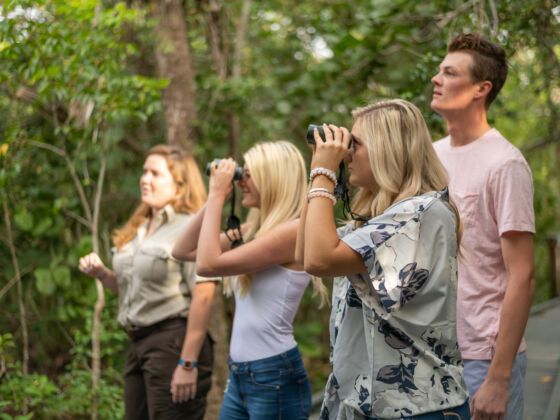6 places to see incredible wildlife on The Beaches of Fort Myers & Sanibel
The Beaches of Fort Myers & Sanibel may be best known for world-class stretches of sand, but just steps inland — within the mangroves, estuaries, and wetlands — hide thousands of reminders of how wild Southwest Florida still is. Sure, check out the beaches when you’re here, but also make time to seek out animal tracks. Listen for birdsong. Glimpse rippling waves and corner-of-your-eye splashes.
From classic family favorites like dolphins and manatees to camera-ready roseate spoonbills, ibises, and painted buntings, here’s where — and how — you’ll find plenty of wild company on your next trip to The Beaches of Fort Myers & Sanibel.

This massive preserve on Sanibel Island protects the largest undeveloped mangrove ecosystem in the United States, renowned for its 245+ species of migratory birds. Most exploration takes place along the four-mile Wildlife Drive, which you can tackle on your own — but excellent 90-minute tram tours of the refuge are also available, narrated by expert naturalists.
Beyond the main road, be sure to explore this serene wetlands habitat via its hiking trails — such as the four-mile Indigo Trail — for a good chance at communing with its shyest residents.
Species to look for: Yellow-crowned night herons, manatees, pelicans, egrets, and roseate spoonbills are some of the most spectacular creatures who call “Ding” Darling home. But those are just the big’uns — also keep an eye out for tree frogs, turtles, marsh rabbits, and cuckoos.
Other info for your visit: Consider coming with bikes or a kayak — you can cycle Wildlife Drive and paddle just off it into the mangroves. Fishing and boating is also allowed in the park, and there are nature cruises along the waterways.
Practicalities: Migratory birds can best be spotted during the winter months, but summer is more laid-back, with fewer crowds. Also, increase your chances of wildlife sightings by timing your visit for low tide. Admission is $10 per vehicle, or just $1 per pedestrian or bike.
Get a taste of Florida as it used to be at this under-the-radar spot in Fort Myers, featuring a scenic 1.2-mile boardwalk through vibrant wetlands and a beautiful butterfly garden. Expect lots of looking up: This is one of the highlights along the Great Florida Birding Trail.
The slough covers some 3,400 acres of wetland ecosystem and serves as a wildlife corridor for creatures making their way through the area. Simply settle in and enjoy the show.
Species to look for: Pileated woodpeckers, barred owls, and river otters are often spotted (and heard) throughout the preserve. Countless migratory birds — over 30 species of warblers alone! — also frequent the area as a winter residence, while alligators can be seen year-round.
Other info for your visit: The seasons are clearly delineated here — you’ll get very different experiences from summer to winter, as even the appearance of the slough changes depending on if you visit during the dry (Oct–May) or rainy (June–Sept) time of year. Bottom line? You should visit more than once!
Practicalities: Admission is free with a $1/hour parking fee, with a maximum of $5 per visit. Surprisingly, given how relatively unknown it is, the preserve is located just a few minutes off I-75.
Despite being the largest city between Tampa and Miami, Cape Coral remains a naturalist’s haven thanks to its myriad canals and waterways. Birds wade in the mangroves, manatees swim up the canals, and herons fly over the Four Mile Cove Ecological Preserve.
Species to look for: Burrowing owls, bald eagles, and ibises are known to make their home in and around Cape Coral. Herons, tortoises, dolphins, and skittering geckos can also be found within the Four Mile Cove Ecological Preserve, and bobcats pop up on occasion, too.
Other info for your visit: The annual Burrowing Owl Festival in Cape Coral is a hoot. The event includes wildlife expert lectures and speakers, flora and fauna tours, local artists and crafters, a silent auction, and even its own burrowing owl mascot.
Practicalities: There is no fee to wander Cape Coral or the Four Mile Cove Ecological Preserve; however, consider helping protect the local wildlife by donating to the Cape Coral Friends of Wildlife “Adopt a Burrowing Owl” campaign.
The best way to get up close and personal with the area’s abundant water life — both flora and fauna — is to explore this legendary 190-mile marked canoe and kayak trail. Follow the signs (black on white, with an orange border) as you paddle the coastal waters from Pine Island Sound to Estero Bay and up the Caloosahatchee River, from open waters to back bays to forested mangroves and back again.
Species to look for: Bald eagles, great blue heron, and tarpon are a few of the most iconic species that are often spotted along the trail. It’s also not uncommon to spy dolphins and manatees in the shallow waters.
Other info for your visit: The Blueway isn’t a single linear trail. It encompasses three distinct regions of Southwest Florida’s Gulf Coast, including Estero Bay, Pine Island and Matlacha Pass, and the Caloosahatchee River and its tributaries. You get to choose which part of the maze to tackle.
Practicalities: Map out each section of the journey on The Beaches of Fort Myers & Sanibel website. And, while you’re at it, check out the Battle of the Blueway SUP Race held every year on Fort Myers Beach.
Post up at the beach or wander the trails in search of wildlife in this choose-your-own-adventure paradise, complete with pristine sand and epic sunsets. Simply put, this state park rivals any you’ve ever been to.
While many visitors never make it past Lovers Key’s iconic two-mile beach, the park hides a natural wonderland with more than five miles of trails located along its scenic backwaters — which are never empty of wildlife, but nearly totally devoid of other human beings.
Species to look for: Roseate spoonbills, snowy egrets, and gopher tortoises can be admired along paths like the 2.6-mile Black Island Trail. The park also features a butterfly garden and freshwater pond populated by a variety of shorebirds and alligators.
Other info for your visit: Lovers Key, once only accessible by boat, offers some of the most undeveloped, pristine, white-sand beaches in Florida, if not the country. But beautiful shady hammocks rest just beyond the shore, so make sure to see it all. You can also explore the area by kayak — or even celebrate a wedding on the beach!
Practicalities: Admission is $8 per vehicle. Kayaks, canoes, and bike rentals are available via park concessionaire Lovers Key Adventures.
As the largest old-growth bald cypress forest in North America, this sanctuary provides a classic Old Florida experience. Navigate a lush Everglades-esque ecosystem to admire the rugged natural beauty of this undeveloped landscape located just 30 miles east of the coast — but seemingly in another world.
Species to look for: Alligators, woodstorks, tree frogs, and painted buntings are just a few of the many animals who will help keep you company here. But don’t be surprised if a few white-tailed deer and red-bellied turtles join the party.
Other info for your visit: The sanctuary’s 2.25-mile boardwalk is the centerpiece of the property, where you can stroll the verdant landscape amidst towering 130-foot trees draped with mosses and ferns. Have that camera ready!
Practicalities: Advance registration is required, with timed entry available from 8am to 3pm daily to facilitate one-way travel along the boardwalk. General admission is $17, and visitors can register here.

